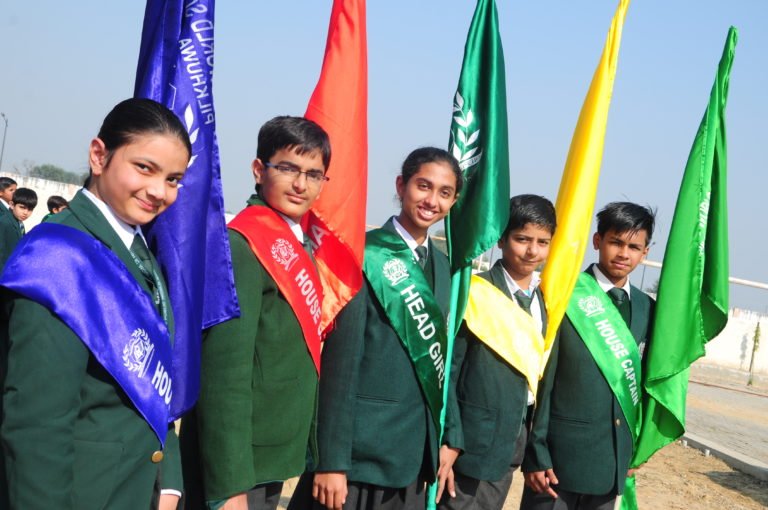
- House System
- The school is divided into subunits called ‘Houses’ and each student is allocated one House the moment he/she is enrolled in the school. Rivers are the theme of the Houses as they symbolize a flow of life and energy. Houses will compete with each other in sports and co-curricular activities, thus providing a focus for group loyalty. Each House is identified by its own colour. Dedicated students exhibiting leadership qualities will be designated as House Captains and Prefects. They will assist the House Master/Mistress in the smooth functioning of the house.
- BRAHMAPUTRA (YELLOW)
- Brahmaputra means ‘the son of Brahma’.
- In mythological times, Amogha, the wife of sage Shantanu, had a child by Brahma (the creator of the universe) and the child took the form of water. Whereas in the Indian sub-continent, most rivers are designated as female, the Brahmaputra is a rare river to have a male designation.
- The Brahmaputra is a trans-boundary river and one of the major rivers of Asia. With its origin in the Angsi Glacier, located on the northern side of the Himalaya in Burang, it flows across Southern Tibet to break through the Himalayas in Great Gorges. It has many names such as Tsangpo in Tibet, Brahmaputra in India and Jamuna in Bangladesh. It is an important river for irrigation and transportation. Its average depth is 124 feet. Its major tributaries are Raidak, Dibang, Sankosh, Amochu, Lohit, Bhareli and Burhidihing.
- KAVERI (GREEN)
- Kaveri, also spelled Cauvery, is the sacred river of southern India. In its mythological reference, King
- Kavera performed tapasya, Lord Shiva appeared and blessed him with a daughter, named Kaveri, who was later married to Sage Agastya. One day, Sage Agastya went to a lake for a bath. Since he could not leave Kaveri alone in the ashram, he turned her into water and put her in his ‘kamandala’. Meanwhile, Ganesha took the form of a crow and overturned the kamandala. The water was released and Kaveri became a river.
- Tamil literature celebrates its scenery and sanctity and considers its entire course as holy ground.
- Rising in the hills of Brahmagiri of the Western Ghats, it surges in a south-easterly direction through the states of Karnatakaand Tamil Nadu, descending the Eastern Ghats in a series of great falls. Before emptying into the Bay of Bengal, the river breaks into a large number of
- distributaries forming a wide delta called the “garden of southern India”. The Kaveri’s main tributaries are Kabani (Kabbani), Amaravati, Noyil, and Bhavani.
- NARMADA (RED)
- Narmada is one of the five holy rivers of India. Its origin is the Narmada kund on the Amarkantak hills in Madhya Pradesh. It is also called Reva and Purva Ganga. It flows through Maharashtra, Madhya Pradesh and Gujarat.
- There are many fables about the origin of the Narmada. According to one legend, Lord Brahma, was moved to tears and two tear-drops fell to the ground, thus creating the Narmada. It is said that its waters are ‘the purest of pure’ and just gazing at the river cleanses the soul and mind. The Narmada River is also worshipped as mother goddess by Narmadeeya Brahmins.
- Its major tributaries are Banjar, Sher, Dudhi, Tawa, Ganjal, Kundi, Goi, Kanjan, Heeran, Barua and Kolar.
- YAMUNA (BLUE)
- The Yamuna is the largest tributary of the Ganga in northern India. It is the longest river in India which does not directly flow to the sea.
- It originates from the Yamunotri Glacier at a height of 6,387 meters on the south western slopes of the lower Himalayas in Uttarakhand and travels a total length of 1,376 kilometers. Yamunotri, the place of origin of river Yamuna, is worshipped as the seat of Goddess Yamuna and is considered as one of the four sites in India’s Char Dham pilgrimage.
- The major tributaries of this river are the Tons, Chambal, Betwa and Ken. The river flows through the states of Delhi, Haryana and Uttar Pradesh before merging with the Ganga at
- TriveniSangam, Allahabad, the site for the KumbhaMela which takes place every twelve years. The TajMahal is situated on the banks of Yamuna River, which makes it earn a special place in the history of India





